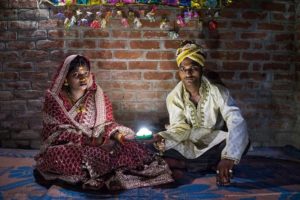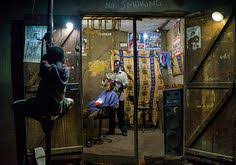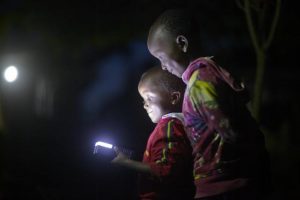Clean-energy lights are transforming lives—and creating entrepreneurs—in Africa and India.
Prashant Mandal flips on a candy-bar-size LED light in the hut he shares with his wife and four children. Instantly hues of canary yellow and ocean blue—reflecting off the plastic tarps that serve as the family’s roof and walls—fill the cramped space where they sleep. Mandal, a wiry 42-year-old with a thick black beard and a lazy eye, gestures with a long finger across his possessions: a torn page from a dated Hindu calendar, a set of tin plates, a wooden box used as a chair. He shuts down the solar unit that powers the light and unplugs it piece by piece, then carries it to a tent some 20 yards away, where he works as a chai wallah, selling sweet, milky tea to travelers on the desolate road in Madhotanda, a forested town near the northern border of India.
“My life is sad, but I have my mind to help me through it,” Mandal says, tapping the fraying cloth of his orange turban. “And this solar light helps me to keep my business open at night.”

Holding a solar-powered lamp, Soni Suresh, 20, and Suresh Kashyap, 22, celebrate their marriage ceremony in Uttar Pradesh, where 20 million households lack electricity.
Mandal, whose home sits illegally on public land at the edge of a tiger reserve, is just a tiny cog in a surging new economic machine, one that involves hundreds of companies working aggressively to sell small solar-powered units to off-grid customers in developing nations to help fill their growing energy needs. Roughly 1.1 billion people in the world live without access to electricity, and close to a quarter of them are in India, where people like Mandal have been forced to rely on noxious kerosene and bulky, acid-leaking batteries.
Mandal’s solar unit, which powers two LED lights and a fan, is energized by a 40-watt solar panel. Sun beats down on the panel, charging a small, orange power station for roughly ten hours at a time. Mandal leases the kit from SimpaNetworks. A for-profit company with a name derived from the notion of “simple payments,” Simpa offers subscription plans structured to fit the budgets of low-income consumers. Even so, the equivalent of roughly 35 cents a day is a massive expenditure for Mandal, who supports his family on a razor-thin budget of less than two dollars a day. Food costs money, as do schoolbooks, medicine, and tea. His middle son, who’s 15, fell ill late last year, and the hospital bill plunged the family into debt exceeding $4,000.
Nevertheless Mandal says that spending 20 percent of his earnings on Simpa’s services is better than living so much of his life in total darkness. “I was spending that much to recharge a battery before,” he says. “I would walk about one kilometer back and forth up the road to recharge it. Sometimes battery acid would spill and burn me. One time it spilled and burned right through the fabric of my pants—all for power.”
Mandal’s struggle is replayed in villages in Myanmar and in Africa, where private companies are selling people solar units and panels and building solar farms. The International Energy Agency estimates that 621 million people in sub-Saharan Africa have no electricity. Because of insufficient power lines in India, only 37 percent of the nearly 200 million people in Mandal’s home state of Uttar Pradesh use electricity as their primary source of lighting, according to 2011 census data. Simpa calculates that 20 million households there rely mainly on government-subsidized kerosene. Throughout the small farm towns, mobile phones are charged using tractor batteries; hundreds die of heatstroke each summer, when temperatures can soar to 115 degrees Fahrenheit; and the grimy black soot released by kerosene scars human lungs. Mandal’s neighbors who have electricity say that it stays on only two to three hours each day, with no alerts from the government about when the blackouts will start or end. Mandal, however, would have no viable source of power without solar because of the improvised nature of his home.
Simpa CEO Paul Needham, who used to work in Microsoft’s advertising department in Washington State, lives a far more privileged life in India than Mandal could ever dream of. He has running water in his home and a near-steady flow of electricity and Wi-Fi. Originally from Vancouver, Canada, Needham moved to India in 2012 hoping to help bridge the gap between people like himself and Mandal. “In many ways India is a divided society, because after decades of rapid development, rural areas like these still lag behind major cities,” he says. “Our customers can’t wait for a better power grid to be built. They need power now.”
Roughly 1.1 billion people in the world live without access to electricity, and close to a quarter of them are in India.
Needham explains that he got the idea for his company while visiting with members of a women’s rights organization in Tanzania in 2010. He saw people paying a neighbor to recharge their cell phones using a solar panel she owned. “It dawned on me that this could really be viable as a business model,” he says. “Solar could be sold.”
In India’s rural marketplaces, sellers profited from solar for years before companies such as Simpa began offering their services to customers like Mandal. In stalls the size of closets men show off inexpensive solar units by cooling themselves under a fan. Customers drawn in by the demonstration interrogate the sellers, who show them thin red and blue wires that could connect to lightbulbs, mobile phones, or fans. These solar units, which are labeled falsely with brand names such as Rolex, Gucci, and Mercedes, cost three to four dollars—a fraction of what Mandal pays Simpa every month. The problem with these models, according to Needham and others in India’s burgeoning solar services industry, is that they’re poorly made and frequently fail.
Julian Marshall, a professor of environmental engineering at the University of Minnesota, says the solar-service industry has great potential to thrive and to improve people’s lives in developing countries, calling it a “feel-good story.” Marshall monitors air pollution inside homes of customers both on and off the grid, researching the damage inflicted by kerosene and other dirty-energy sources. Across India, fumes from kerosene lanterns combine with soot spewed by coal-burning power plants, triggering heart attacks and lung damage in many people. Marshall credits around half a dozen solar companies, including Simpa, for taking an innovative approach to sales in rural India. “The customer makes the decision to buy solar services primarily for personal financial reasons,” he says. “But health and environmental benefits for the community come along with it, and I think that’s great.”
The chance to escape India’s blistering heat is perhaps the strongest incentive for leasing a solar system. Shiv Kumar, a 20-year-old laborer in Madhotanda, makes his living gathering hay for farmers, earning less than $2.50 on the days he works. When food is scarce, he sometimes works for grain rations. The home he shares with his father and brother is concrete, with two tiny rooms that offer little ventilation. So when a sales associate from Simpa demonstrated the solar kit, it was the fan that sold him. “The kerosene lamp was dim and yellow and made me feel depressed,” Kumar says, standing in the fan’s breeze. “But this is the best fan I’ve seen.”
Neel Shah, a Simpa product management leader, can attest that the challenges of bringing solar services to rural areas often stretch beyond whether people can afford them. One time men traveling on Shah’s train attacked him. Another time villagers in the district of Mathura warned Shah that members of a gang, known for wearing just underwear and lubricating their bodies with oil to avoid capture, were coming that night to loot homes. The villagers apologized to Shah and escorted him to a rickshaw. Uttar Pradesh, India’s most populous state—with 40 percent more people than Russia—is also its most chaotic. Gangs and violent crime are endemic, as are elected officials with criminal records.
The solar business can be frustrating, but customers like Mandal make it worth it,” says Shah, who met Mandal earlier this year after Mandal called Simpa to express his admiration. “We want to see a million people like him with light.”
Back in Madhotanda, inside the tent where he sells tea, Mandal reassembles his solar unit and hangs up the lamp. The space is empty in the punishing heat of the afternoon as he stirs the tea in a metal cauldron lit by a wood fire. A few passersby will arrive by sundown, when the air cools.
Mandal wishes he could lease a second solar unit so that his children could have a more secluded place to study. But for now his priority is growing his business, a goal he believes solar power can help him achieve.
“When customers see the lights,” he says, “they will come.”
Award-winning photographer Rubén Salgado Escudero began his career as a 3-D video game animator. Born in Spain and now based in Myanmar, he focuses his photography on overlooked people and places.





Leave a reply